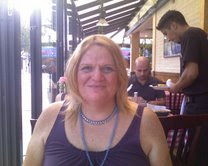Lately, I’ve been listening quite a bit to WBAI, the Pacifica Radio station here in New York. I have gone through periods of my life when I have listened to no other radio station—sometimes, during times when I wasn’t watching television.
I started listening again a few months ago because
there is so little on local radio or television I can stand, even as background,
while I’m working on something. At other
times when I listened regularly, there were more intelligent, engaging or
simply entertaining (by my standards, anyway) options in the media than there
are now. I know that I can find some
favorite old episodes and programs on You Tube and other venues, but I don’t
want to spend too much time on reruns.
Besides, it’s hard use You Tube or its equivalents as background.
Anyway, WBAI has an “OUT Radio” program, which claims
to be the only LGBT-centered radio program in the NYC area. Their claim is probably accurate. I hadn’t tuned in specifically to hear that
program, though: I’ve had the radio on
most of the day as I’ve gone in and out to shop for food and do laundry and
other errands—all within a two-block radius of my place. Still, I listened. I’m glad I did: the producer—I didn’t catch her
name—interviewed Jay Toole.
Until recently, Jay headed Queers for Economic
Justice. However, the organization is
dying because it’s lost its funding. But
Jay had been working on a dream, which is now coming into fruition: Jay’s House, a shelter/community center for
LGBT people.
Jay’s vision for it was borne of experience living in
the New York City shelter system and, before that, on the streets. Like too many other young queer people, Jay
became homeless upon “coming out” as a teenager. To be exact, Jay was 13 years old at the time
and would live without a home for more than thirty years afterward.
One of the things for which I am thankful is that the
most difficult times I’ve experienced are nothing like what Jay experienced
every day for decades. Another thing for
which I’m thankful is for which I’m thankful is having met Jay, especially at
the time in my life when I did.
Not long before I moved out of the apartment I’d been
sharing with Tammy, I went to Center Care, the counseling center of the LGBT
Community Center of New York. Jay
volunteered as an intake counselor and was on duty the day I walked in. Until that day, Tammy was the only person
with whom I’d talked about my gender identity.
Actually, I didn’t talk about it so much as I insisted that the
clothing, the jewelry and the time I spent in them were things I could simply
“walk away from” if and when it ever became a possible roadblock to her
career—or, more precisely, her own life based on her defying other people’s
perceptions of her real and understandable wish to escape the pain
other males in her life had caused her.
Living a half- (or otherwise partial-) truth really
isn’t any better—or, at least, mentally and spiritually healthy—than living an
outright lie. Well, it might be better
in the sense that sometimes it’s necessary to live that partial truth—which,
really, is another kind of mendacity—in order to learn whatever one must learn,
or simply to survive, before facing reality.
I knew I had to end those fictions—and the ones I’d
given my family, friends and anyone else who knew or questioned me—on the day I
met Jay. As I sat in the Center’s
waiting area, I thought about how I would explain myself to whoever I met. (At that moment, of course, I didn’t know
that person would be Jay.) Until that
moment, nothing made any sense to me: I
didn’t know, therefore, how I could make it make sense to anyone else.
The receptionist called my name and directed me to one of the Center’s narrow but well-lit offices. “I’m Jay.” “Hi.”
At that moment, I forgot whatever I’d been rehearsing
in my mind. Instead, this passed through
my lips: “I’m a woman.”
“I know.”
I would later realize that, at that moment, I knew Jay,
too, even though we were meeting for the first time. You see, I intuited—and much later
articulated—this: I was, at that moment,
an inversion of Jay, who was about as “butch” as anyone could be without having
been born with XY chromosomes. But, even
more important, we had both been defined by our vulnerability and pain. Both of us had experienced sexual molestation
and violence; while Jay was cast out, I alienated myself because I simply could
not relate to anyone else, not even members of my own family. Jay had spent more than three decades without
a physical home; I’d spent about the same amount of time, if not more, unable
to be at home in my own body, in my own mind, in my own spirit, let alone in
any physical environment in which I’d lived, worked or been inculcated with
notions to which I simply couldn’t conform, no matter how hard I tried or how
much I loved the people who were teaching the lessons they’d been taught and,
in some cases, did not understand.
Jay and I would later volunteer on one of the Center’s
projects and remain in contact, if episodically. Although Jay is very busy, the time in which
we didn’t talk or write much to each other was also my fault: I withdrew from almost everyone with whom I
didn’t have to be in contact when Dominick was doing everything he could to
destroy me. I didn’t have to make the
apology I offered when we bumped into each other, for the first time in a couple of years, back in June: After all, almost no one else I know
understands what it’s like simply to survive the day and the day before as well
as Jay does.









